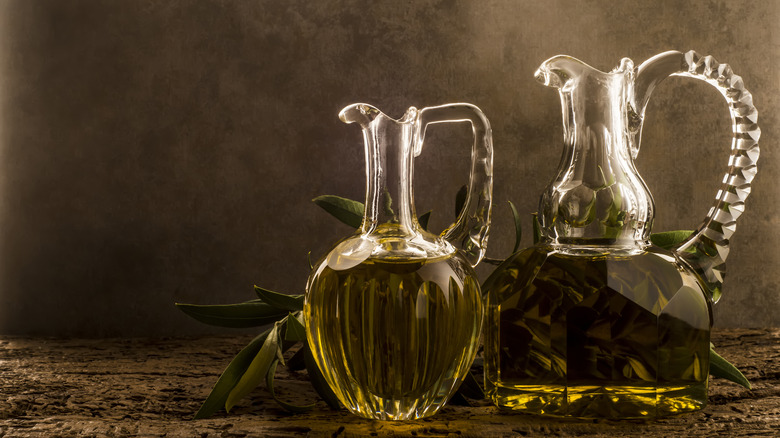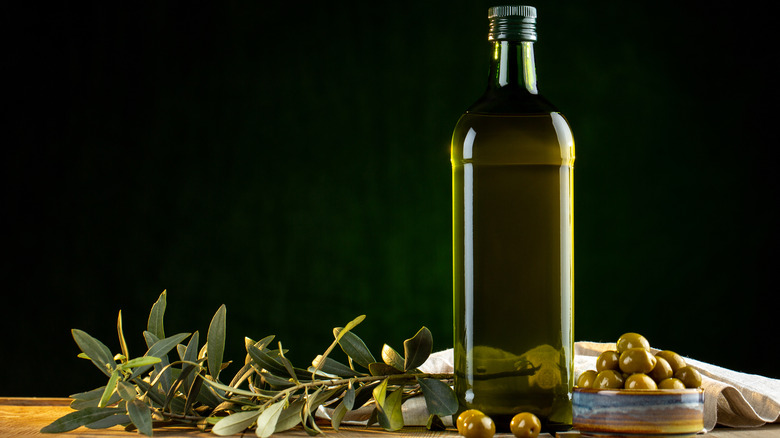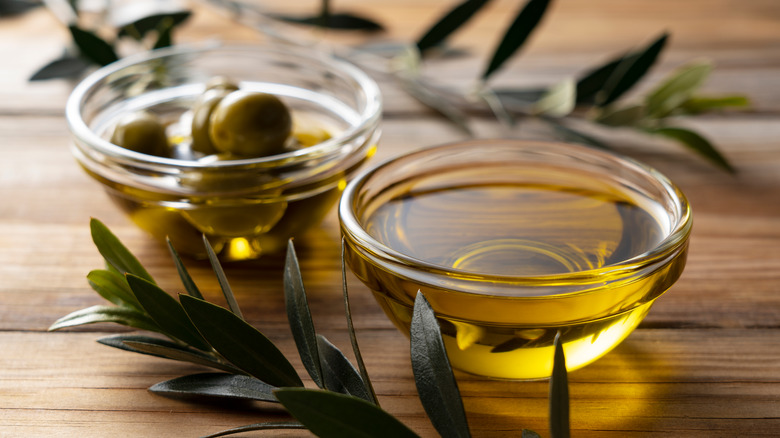The Major Differences Between Spanish And Italian Olive Oil
Correction 8/17/22: Originally this article indicated olive oils labeled "product of" could contain oils from multiple origins. According to the USDA all countries must be listed on the label if it includes Country of Origin Labeling.
Options are abundant for olive oil, and the olive oil section at the grocery store can pose a challenge. How do you efficiently and confidently choose the best-tasting or best-value bottle? For starters, like wine or any food for that matter, it's difficult to say what will taste best since taste is so specific to the individual, says How Stuff Works. It's a good idea to experiment with what tastes good to you within your price range.
That said, several guidelines and tips ensure you get high-quality olive oil. Many may want to use the olive oil's country of origin — like Spain or Italy — as the prime determining factor. While each region and variety does affect the taste, first, it's best to know how and where to look for the best olive oil on the shelf. Then, you can consider the olive oil's region.
Premium extra virgin olive oil is superior and best used fresh as a topping, drizzle, or condiment. Extra virgin olive oil is next in line for high quality, per How Stuff Works. This is because extra virgin olive oil is the least processed and is chemical and additive-free, says Bon Appétit. Next, pick a dark-colored bottle. Olive oil spoils quickly, and clear bottles speed up the process. If you're wanting to avoid pesticides, anything certified organic is the way to go.
Identifying the country and region of origin
Once you've narrowed down your selection to high-quality olive oil, you can begin thinking about the olive oil's place of origin. According to Bon Appétit, the best way to identify the olive's area of origin, look for the country initials on the back of the bottle (for example, ES for Spain and IT for Italy).
Companies may use different varieties of olives from various locations for one batch of olive oil. If you want to ensure that your olives come from the same place, seek out an "estate oil." The estate oil label means that all of the olives come from the same location and source, says How Stuff Works.
Lastly, check to see if the bottle has a harvest date. Olive oil has a limited shelf life, and using the freshest olive oil possible ensures the best flavor, advises Food & Wine. If you have some older olive oil on your shelf, use it for cooking and save your newer bottle for topping, dipping, and drizzling.
Italy versus Spain
Now that you know how to identify precisely where your high-quality olive oil comes from, you can begin to think about region and flavor. Regional differences don't affect the thickness of the olive oil, says Livestrong. However, olive oils from different parts of the world have notable flavor differences.
Spanish olive oil is vastly diverse, with over 200 different varieties of olives, according to Martha Stewart. Though of course not always the case (thanks to that diversity mentioned), Spanish olive oil is characteristically yellow-gold in color due to the country's climate. The taste, generally, is nuttier and fruitier than its Italian counterparts. Spain produces roughly 45% of the world's olives, making Spanish olive oil widely available, per How Stuff Works.
Italian olive oil is typically a darker green, has a grassier taste, and a more herbal smell. That said, the specific region of Italy your olive oil comes from affects the taste. Martha Stewart reports that olives from Northern Italy produce a lighter, milder olive. In contrast, central region olives have a much stronger flavor with significantly grassier notes. Southern Italian olives, which are the most common, tend to taste more herbal. Italy only produces 20% of the world's olives. If you're seeking out true Italian olive oil, make sure you read the label carefully.
Experiment with these guidelines to determine which olive oil works best for you.


